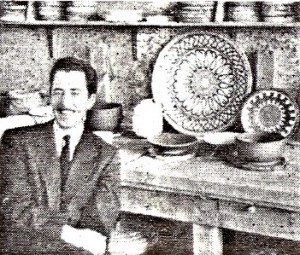Jean Cartier Capsule:
Dates: 1924-1996
Production Dates: 1945 ff
Location: Montreal, St Jean-sur-Richelieu
Types of Work: Functional, Sculptural, Architectural.
Preferred Kiln Type and Firing Process: kiln type unknown; probably reduction firing
Preferred Clay: earthenware, stoneware and porcelain.
Signature/Mark/Chop:

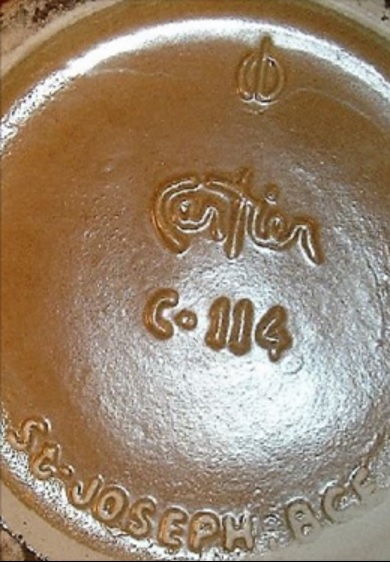
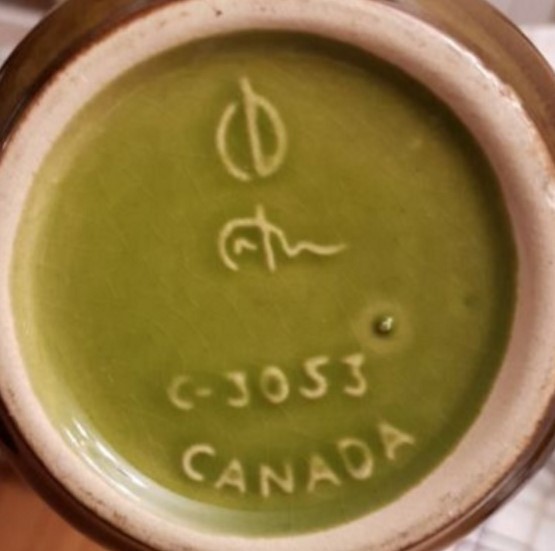
.
Biography
So many times one comes across artists who, once more widely recognized and respected, are today much less known across Canada. This page is about Quebec ceramist and muralist Jean Cartier who inspired a generation of Quebec and Ontario artists and whose works and designs are still avidly collected.
His early life and career are fairly straightforward; his later career more varied.
A native of Saint-Jean-sur-Richelieu he initially took classical studies at the Institut classique et commercial de Montréal. By 1945 at the age of 21 he learned the basics of ceramics spending a winter with ceramist, Adriene Villandré in St. Jean.15 The next step was enrolling in the ceramics programme of l’ École du meuble de Montréal from which he would graduate “with distinction,” and scholarships in 1949. ³
The École du meuble de Montréal, the Montreal Furniture School, is to our contemporary ears a peculiarly named institution. Yet it was multi-disciplinary and critical to the development of ceramics in Quebec in the mid-twentieth century. Many well known ceramists were graduates, including Gaetan Beaudin, Edith Legros-Wise, Alain-Marie Tremblay.
The school reflects the Quebec government’s interest and support in those early years for industry and craft, culture and lost traditions. Founded in 1935 the school would go through a number of transformations: in 1958 it became l’Institut des arts appliqués (Institute of Applied Arts); then in 1969 it was absorbed into the Cégep du Vieux Montréal. The ceramics program was run by the academically oriented Pierre-Aimé Normandeau. Although his students remember his teaching style as less than inspiring Normandeau’s name is a consistently and respectfully mentioned by artists such as Gaétan Beaudin and Alain-Marie Tremblay.
Cartier graduated in 1949 and for the next two to three years (1949-51) took a familiar Quebec artist path, studying in France, particularly Paris. The two schools of interest were l’Académie de la Grande Chaumière and the more famous Académie Julian, the latter particularly popular with foreign students. In the latter he was more interested in drawing. He continued with final studies in ceramics at the Atelier Jean Besnard and sculpture with Ary Bitter.³
After his return to Quebec, Cartier was a respected instructor at the École du meuble de Montréal from 1952-1962.9 In 1953 as a popular guest instructor at the annual meeting of the Canadian Guild of Potters in Toronto he demonstrated his slips and glazes, bringing samples of his work and lecturing with coloured slides. The Guild members were particularly impressed with his wax resist methods and his generosity in sharing his glaze recipes finding his “new approach was most stimulating.” ¹
In 1954, he won the first prize in the Québec Decorative Arts Competition (premier prix du concours des arts décoratifs du Québec).9
Further international studies followed when in 1959 he went to Sweden. There he picked up methods of a more ”industrial” production of works. He enrolled in the Konstfackskolan, (School of Applied Arts), where he experimented with stoneware and porcelain pastes and glazes, drawing and studying forms. This stay in Sweden influenced his ceramics’ clean Scandinavian designs.10 While in Sweden true to his encyclopaedic nature and wide interests he also developed an interest in glass blowing after visiting the Orrefors factory; and while in Gustavsburg he studied mural enamelling on steel,11 a technique he was to use in much later in Montreal Métro commissions.
Back in Canada he first connected with the Ceramique de Beauce factory in 1968, and in 1970 he became their senior ceramic designer.² The influence of his Scandinavian experience is now seen in his Beauce designs such as his famous “cocottes” (casseroles). His often minimalist, modernist designs helped turn around the fortunes of the factory. Today they are much sought after by collectors.
Throughout his career Cartier generously shared his knowledge and skills, working with many other famous Quebec artists: Jordi Bonet, Claude Vermette, Jacques Garnier, and Alain-Marie Tremblay to name a few
Such was the respect for the artist and the man that the award he originally won in 1955 was renamed as le prix de la relève Jean-Cartier.
Ironically even though he was an avid learner Cartier saw himself more as a doer than a student. In an interview given in 1988, he said:
“I hated studying and wanted to create something with my hands.” ³
Cartier was a prolific artist in many media and on many scales. To name just a few: in addition to his studio and industrial designs: the ceramic façade on the Saint-Jean-sur-Richelieu Town Hall on which he collaborated with Jordi Bonet; the Canada Pavilion at the 1958 World’s Fair in Brussels; the Port-Royal Theater at Place des Arts in Montreal (renamed since Théâtre Jean-Duceppe). He also produced steel enamels for the Montreal subway stations, Papineau 14 and Cadillac; and constructed a luminous glass, concrete and steel fountain on the site of Expo 67, La Giboulée, “Sudden Shower”. He even created, on the small scale, jewellry, setting up a studio in L’Assomption in Saint-Joseph-de-Beauce, where he designed pebbles and ceramic jewellery.³
Jean Cartier died in Montreal in November 1996.³
Perhaps the essence of Jean Cartier, reflected in the respect shown him, is seen in how he also supported and encouraged others, literally. A measure of the artist and man who could generate such respect can be seen in the words of Huguette Bonet, the wife of Jordi Bonet, who collaborated on major commissions, with Cartier.
” She candidly admitted that Jean Cartier allowed them to put butter on their bread” 5
A Jean Cartier Gallery
Cartier Studio Ware

This type of early Vase, 1952, of thrown red earthenware with white glaze, wax resist decoration, interested the Toronto group of the Canadian Guild of Potters:
“ His work was of special interest to the group because of the rough texture of the glaze and the use of contrasting spots or stripes of glaze which, at a distance, resembled jewels set into the body of the piece. His work has a ruggedness and strength too often lacking in present day pottery. “ ¹
This celadon cache pot has a simplicity of form and glaze surface. The date of the work suggests not only a Scandinavian inspiration but also an experiment. The results were not one he explored much further.
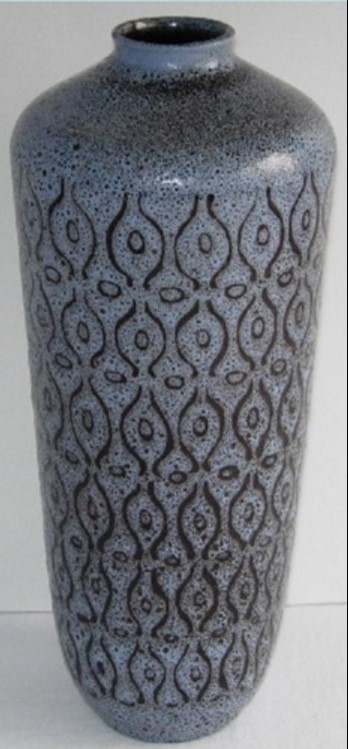
Jean Cartier vase. This tall, elegant, and high-shouldered vase is a frequent form in Cartier’s work. The glaze design is looser than in the earlier work above. The black “eye” design is flowing, a vertical repetitive pattern against a speckled blue-grey background and ends at the high shoulder curve. The whole presents a faintly “islamic” look.

The large bowl displays a marked difference in surface treatment. The rim and lip are deeply scored in an even ray pattern of blue and black that creates a two tiered effect of density and depth. Meanwhile the well is simple, terracotta colour that shows the wheel thrown origin of the work.
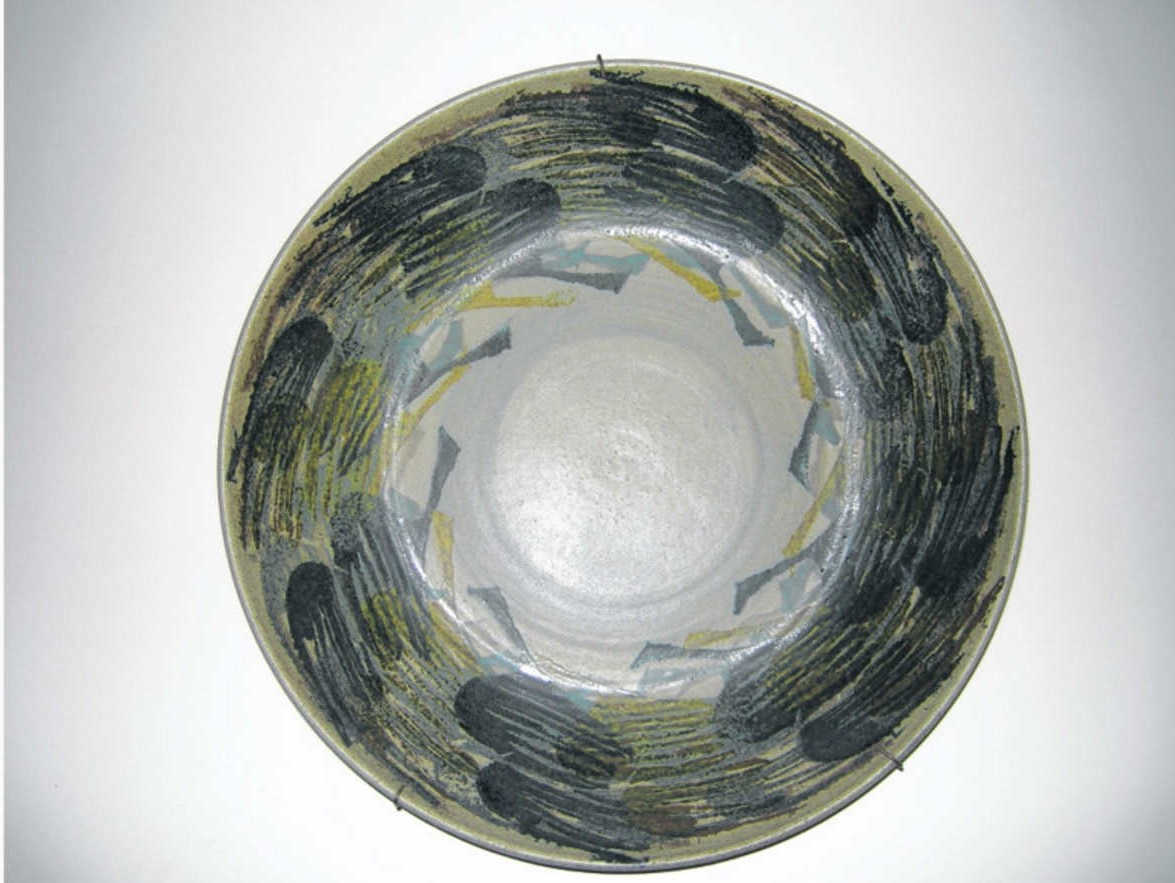
His Large Wall Plate by contrast is flatter in its surface decoration, the design one of broad brushstrokes of black grey and yellow glaze on a yellow-green matrix. The colours filter into the white of the well, shifting into flat, sharper edged stencil forms
Beauceware Designs
As a brief aside, major artists creating designs for a ceramic factory is a unique and major theme in Quebec in the last half of the twentieth century, and would include other renowned Quebec ceramists such as Jacques Garnier and Goyer-Bonneau.16 The Beauce factory products from all periods are ongoing favoured collector’s items:
” Who does not remember those teapots in the bizarre colors, the rococo vases, the aerodynamic cocottes that flooded the homes of Quebec between 1940 and 1989? Formerly part of our daily life, the ceramic of Beauce is today object of museum, collection and … of curiosity.” 4
The number and variety of Cartier ‘s designs for the Beauce factory are amazing. They are meticulously identified with unique catalogue codes. His influence is described:
“ … Cartier, one of Quebec’s most daring ceramists, was a principal designer of Ceramique de Beauce from 1970 to 1974. His creations with pure lines, such as casseroles, dishware and vases, marked a turning point in the evolution of the company.” 4
This Cocotte 1971ff is a classic example of what was termed industrial utilitarian art. With a mid century modern type influence, this has a light colored clay body and splotches of thick sunny yellow glaze on the exterior. The bottom is marked as shown, and includes the model number C-50. Here the emphasis is on the clean lines of the form. The surface designs are almost incidental by comparison.
A Red and black “Skimo” vase, 1970. While basic simple forms were one aspect of Cartier’s design in Skimo ware he also introduced a more complex surface design in relief texture, colour and narrative using symbols and images of Canada’s north, an approach less politically correct today but accepted at the time. The relief images are enclosed within a cartouche almost like “Egyptian hieroglyphics”
Red and Black Skimo Vase. c. 1980. In other versions of Skimo ware Cartier designed more geometrically solid works, almost machine-like in form, such as this cylinder. Here, imagery is now replaced by stacked bands of geometric patterns.


Cartier plays with modernist vase designs: on the left with biomorphic, cut cylinder, or a cubic block with off-centre spout shapes. He also designed a family-like grouping of condiment and oil dispensers on the right.
Murals and Later Works
More accessible to the general public are Jean Cartier’s large works integrated into the architecture of buildings and other public infrastructures,

Jordi Bonet and Jean Cartier Hotel de Ville St Jean-Sur-Richelieu. This facade mural shows not only Cartier’s collaborative skills but also his interest in large scale work that adds grandeur to an otherwise plain municipal building.
Cartier had also studied the making of enamel on steel murals during his stay in Sweden.10 Much later he also created works for the city of Montreal including the Papineau and Cadillac metro stations in Montreal. The Papineau murals, pictured above, reconstruct the adventure of the Patriotes of 1837-1838. A few years later, the artist created two other murals for the Cadillac station, this time composed of oval motifs and provided with a mechanism allowing them to change appearance on occasion.2

An Untitled ceramic mosaic, 2014, in the lobby of the Centre récréatif, Gadbois, Montréal, depicts sports such as weightlifting tennis, diving, among others in a flat, stencil-cut-out design in red, blue green and white. The integration of the action figures into the maze-like design of lines, triangles and curves spread on small tiles is a tour de force in itself and shows Cartier’s comfort with industrial methods and figurative and abstract subjects and design.
La Giboulée

But I cannot resist showing a large non-ceramic work that show the scope of this incredible artist.
Cartier created a concrete, glass and steel fountain, “La Giboulée” (Sudden Shower, Cité du Havre Montréal) for Expo 67. The work rose like a forest of futuristic mushrooms, sprouting in concrete, glass, steel, water and light. Sadly, the work has declined in state, essentially abandoned, a consequence the ebb and flow of government funding for maintenance and conservation.
Jean Cartier’s work can be seen in museums, the secondary market, and public spaces. More people should know of his talent and contributions to society and the arts. I hope this page will help.
Endnotes & Bibliography:
1. The Clay Product News and Record. Several 1953 issues record Cartier’s work and demonstrations in the Canadian Guild of Potters April 23-24 workshop in Toronto
2. Jean Cartier, Musée Virtuel
3. Encyclopédie : Antiquités Antiquaires Collectionneurs Québec AntiquePromotion . Excerpt from: Cogne, Daniel; Dube, Richard; & Trepanier, Paul . BEAUCE POTTERY THE STORY OF BEAUCEWARE AND CERAMIQUE DE BEAUCE. Imprint: Saint-Foy, QC, Les Editions GID, 2004.
4. Fabienne Couturier. La Presse.ca . Redécouvrir la céramique de Beauce. Publié le 14 août 2015.
5. Mario Wilson Le Canada Français. le 23 avril 2015 Jean Cartier, un joaillier très apprécié.
6. Art Public Montreal.
7. Céramique de Beauce: MAGAZIN’ART – 17e année, No 2 – Hiver 2004/2005
Page d’accueil .
8. Normandeau is mentioned in other pages on this Studio Ceramics Canada website
9. Beaudry Dion, Jacqueline & Dion, Jean-Pierre. Céramistes Du Québec. 2nd edition.2011. Self-published.
10. Jean Cartier. “Lettre de Stockholm.” Vie des arts 15 (1959): 16–17.
12. PATRICK POULIN. Thème Picture Window. Fourni par Blogger. LES OEUVRES DE JORDI BONET: première partie Tentative de répertorier les murales,vitraux,sculptures et céramiques parfois oubliés de Jordi Bonet.
14. Art in the Métro, sites for murals.
15. André Laberge en collaboration avec Lucie Brash. Les métiers d’art du Québec et L’histoire. Ministre des Affaires culturelles, Gouvernement du Québec. métiers d’art du Québec. December 1975., p.105.
16. Picard, Michelle et Robert. La Céramique de Beauce. MAGAZIN’ART – 17e année, No 2 – Hiver 2004/2005.
17. oneneote. Première murale de Jordi Bonet avec Jean Cartier 1957.
© 2017 studioceramicscanada.com

